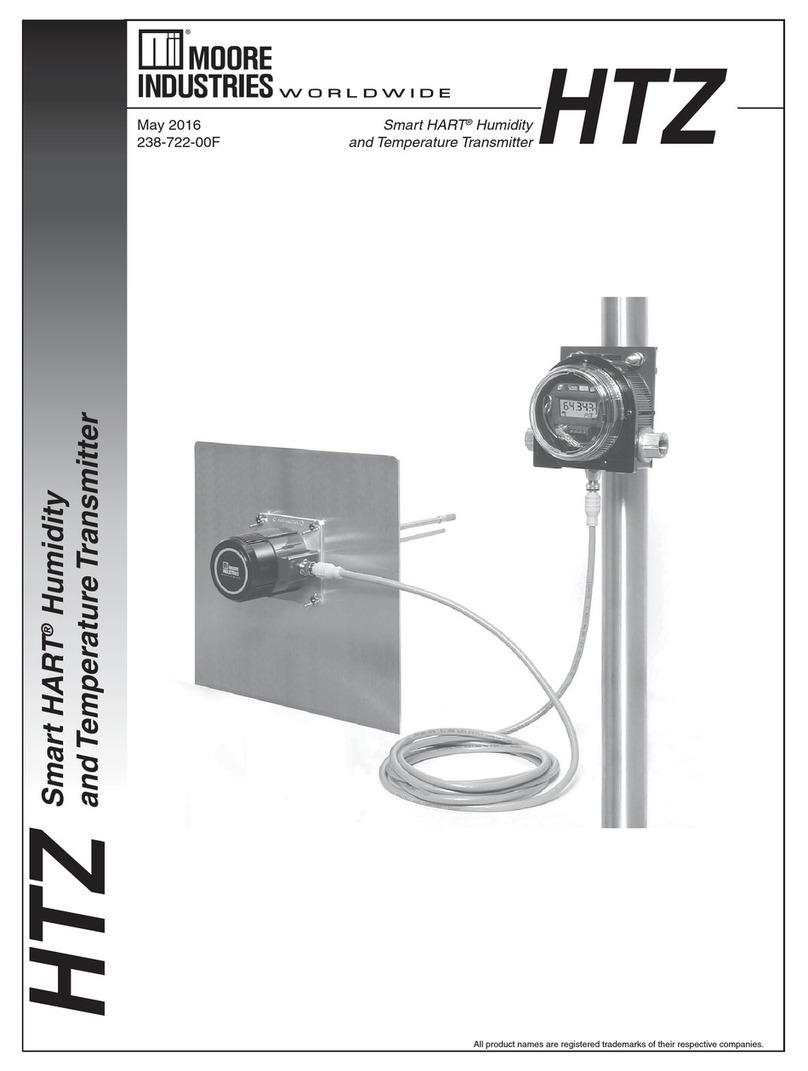
10 Demand Moore Reliability
IPH
2 &IPX
2
Current-to-Pressure
(I/P)
Transmitters
Installation
The installation of the IPH2or IPX2 is carried out in
three phases: the physical mounting of the unit, the
electrical connections phase, and the pneumatic
connections phase. It is strongly suggested that each
unit be calibrated according to the instructions in this
manual before being placed into service.
Installation in hazardous ‘Classied’ locations and
potentially explosive atmospheres must adhere to the
instructions in the Hazardous Location Applications
section which can be found at the end of this
Installation section.
Phase One: Mounting
Figures 1 and 2 give the dimensions of the IPX2and
IPH2, respectively. The illustrations also give the
dimensions of the available option hardware, which is
recommended for most installations. After placing the
unit in the desired location and orientation, secure the
housing with the optional pipe mounting hardware or
other appropriate fasteners.
The IPH2or IPX2will operate when installed at any
angle–either surface-mounted or attached to pipe or
round conduit. However, there are other considerations
in selecting the ideal mounting position. If the IPH2is
in an area which may be exposed to rain or water, it
should be mounted within 45° of vertical. In natural
gas applications, where liquid remnants are possible
in the supply, the vent port of the IPX2needs to be
in a position that would allow for sucient draining.
Please also consider the requirements in Pneumatics
Connections on the next page before determining the
ideal mounting conguration.
Phase Two: Electrical Connections
To complete the electrical connections, route the wiring
through the conduit port to the terminal block, then
use a screwdriver to loosen the terminal screws. (Not
necessary for IPX2–NG1 or –NG2 installation.)
For all units except the IPX2–NG1 or –NG2, connect
positive lead (+) to the +PS terminal, and negative
lead (–) to the –PS terminal. Tighten the terminal
screws until snug.
Caution:
When connecting the IPX2Natural Gas (–NG1 or
–NG2) model, use an appropriately certied conduit
box and wire connectors. Do not attempt to remove
the seal tting, as it is necessary for natural gas
certication. Connect the positive lead (+) to the red
wire from the seal tting, and the negative lead (–) to
the black wire from the seal tting.
Use shielded, twisted-pair wiring for low-level input.
Ground the shielding wire as close as possible to the
installed unit.
Recommended Ground Wiring
Practices
Moore Industries recommends the following ground
wiring practices:
• Any Moore Industries product in a metal case
or housing should be grounded.
• The protective earth conductor must be
connected to a system safety earth ground
before making other connections.
• All input signals to, and output signals
from, Moore Industries’ products should be
wired using a shielded, twisted pair wiring
technique. Shields should be connected to an
earth or safety ground.
• For the best shielding, the shield should be
run all the way from the signal source to the
receiving device. (see Note below)
• The maximum length of unshielded input and
output signal wiring should be 2 inches.
Note:
Some of Moore Industries’ instruments can be
classied as receivers (IPT2, IPX2, etc.) and some
can be classied as transmitters (TRX, TRY, etc.)
while some are both a receiver and a transmitter
(SPA2, HIM, etc). Hence, your shield ground
connections should be appropriate for the type
of signal line being shielded. The shield should
be grounded at the receiver and not at the signal
source.
CE Conformity
Installation of any Moore Industries’ products that carry
the CE marking must adhere to the guidelines in the
Recommended Ground Wiring Practices section in
order to meet the EN 61326 requirements set forth in
the applicable EMC directive.




























